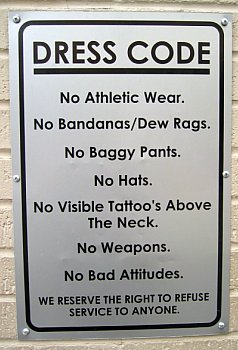
In each society, there are different things that are considered normal in society and should be followed. These different things or rules are called norms. They are different for every society, and especially for America, have changed over the years. The Normative order gives the people within a society an idea of how to behave and, in a general sense, live their lives so as not to get into trouble. When someone breaks the rules, there are sanctions, or consequences, that one must recognize.
One of the norms that have been adjusted over the years in America is dresscode. Looking back in history, one will notice that they dressed vastly different from how we do today. In the 1700's, the women all dressed in floor length dresses and were covered very well. They always looked formal. The men always looked formal too, usually wearing a dress coat with tails and dress shoes. If someone today were to wear this out and about, they would get some odd looks from people. When we looked at the Barrington High School dress code of 1969, our class found that the dress code was completely different from how it is today. Girls were not allowed to wear pants, tight fitting clothes, or spaghetti straps to school, only skirts. Harsh or bold makeup was not allowed, and neither were extreme hairstyles. Boys were not allowed to wear plain white t-shirts, as they were considered underwear, nor were they allowed to wear any shirt with the name of a non-campus group. Today, to see a guy wearing a hollister shirt or a girl wearing blue jeans is completely normal. Our dress code consists of short skirts, tank tops, t-shirts, flip-flops, tight jeans, or shorts. From looking at the dress code in 1969, we can clearly see that norms are adjusted from generation to generation, creating change in the society.
Though some norms have changed drastically, some have not changed quite as much. For example, many of our table manners that were applied during the 1960's still apply today. In class, we talked about how eating with your elbows on the table is considered rude. This rule is dated back all the way to the middle ages in Europe, when the people all wore clothes with long sleeves. If you put your elbows on the table, your sleeves would get in your food, which is messy and rude. So, the rule was created that having your elbows on the table during dinner is rude, and in most cases is still enforced today. Another table manner might be putting your napkin in your lap before you begin eating. Although I'm not exactly sure how far back this rule dates, you'll notice even in movies that were made in the 1960's, everyone put their napkins on their laps before they ate. This rule, in general, has not changed either.
So, norms are what tells the people in a society how to behave, and usually change through the years. When someone does not follow the norm, there are sanctions, or punishments, for their actions that go against the normative order. It's all been engraved into everyone's heads what is right or wrong for our society, but living in another society, there are different norms. Every society is different in this way, and because of this we sometimes have conflict. Maybe if we all learned to accept each other's differences in our own normative order, the world might get along a little better.
No comments:
Post a Comment